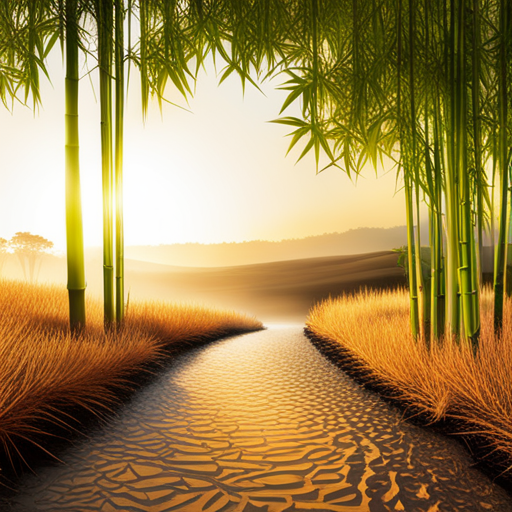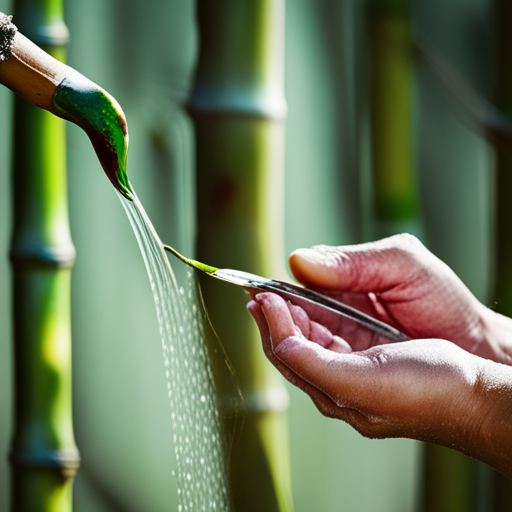Drought is a frequent occurrence in various regions worldwide, necessitating the selection of bamboo species that can withstand dry conditions. While bamboo is generally resilient, some species exhibit greater tolerance to drought than others.
Clumping bamboos typically possess superior adaptability to drought compared to running bamboos. However, it is crucial to note that the presence of a mature and established root mass is essential for bamboo to be considered drought tolerant. Following the initial full season, most bamboo plants do not require additional watering, although their growth may decelerate during exceedingly arid periods. Signs of drought stress include the yellowing and curling of leaves, which can be alleviated through comprehensive watering. Curling leaves in Caladium plants may be a natural occurrence, but if older leaves are curling, it may indicate insufficient watering or high temperatures.
Several clumping bamboo species with drought tolerance include Otatea acuminata aztecorum, Bambusa malingensis, Chusquea culeou, and Phyllostachys aurea. Furthermore, Phyllostachys aurea, Phyllostachys nigra, and Phyllostachys nigra Megurochiku are examples of drought tolerant running bamboo species.
The appropriate care for bamboo entails providing optimal growing conditions such as sunlight exposure, suitable soil, essential nutrients, hardiness, and watering needs. Mulching can also aid in moisture conservation, particularly in dry and hot climates.
Contents
- 1 Our Highlighted Points
- 2 Drought Tolerance Factors
- 3 Watering and Moisture Management
- 4 Recommended Bamboo Species
- 5 Does the Growth Rate of Bamboo Impact Its Drought Tolerance?
- 6 Frequently Asked Questions
- 6.1 How long does it take for a bamboo plant to become drought tolerant?
- 6.2 Can bamboo survive in areas with extremely low rainfall?
- 6.3 What are the signs that a bamboo plant is suffering from drought stress?
- 6.4 Are there any specific soil conditions that can help improve the drought tolerance of bamboo?
- 6.5 What are some common mistakes to avoid when watering drought tolerant bamboo plants?
Our Highlighted Points
- Drought is a normal, recurring feature of the climate in most parts of the world.
- Clumping bamboos tend to be more drought tolerant than running bamboos.
- Mature, established root mass is required for bamboo to be considered drought tolerant.
– Yellowing and curling leaves indicate that the bamboo plant needs water.
Drought Tolerance Factors

Drought tolerance in bamboo is influenced by factors such as species selection, root mass development, and the ability to withstand prolonged periods of no water. Factors affecting drought tolerance in bamboo include the species of bamboo chosen for cultivation.
Clumping bamboos, such as Otatea acuminata aztecorum, Bambusa malingensis, Chusquea culeou, and Phyllostachys aurea, tend to be more drought tolerant compared to running bamboos like Phyllostachys nigra and Phyllostachys nigra Megurochiku.
Another important factor is the development of a mature and established root mass, which enables the bamboo plant to better withstand dry conditions. Signs of water stress in bamboo include yellowing and curling leaves, indicating the need for water. However, it is important to note that while drought-tolerant bamboo species can withstand prolonged periods with no water, there are limits to their tolerance.
Proper care, including adequate watering and species selection, is essential for maintaining the drought tolerance of bamboo plants.
Watering and Moisture Management

Watering and managing moisture levels are important factors to consider when cultivating bamboo plants. Adequate watering techniques play a crucial role in the establishment and growth of bamboo.
During the first year, it is essential to water the plants thoroughly to promote root development and ensure their survival. After the initial establishment period, bamboo generally requires no additional watering, as it is a drought-tolerant plant. However, in extremely dry seasons or prolonged periods of drought, it may be necessary to water the bamboo to prevent stress and maintain its health.
Mulching is another important aspect of moisture management for bamboo. Applying a layer of organic mulch around the base of the plant helps conserve moisture in the soil, preventing excessive evaporation and reducing the need for frequent watering. Additionally, mulching also helps control weed growth and maintains a more stable soil temperature for optimal bamboo growth.
Recommended Bamboo Species

When considering suitable bamboo options for cultivation, it is important to assess the specific requirements and characteristics of various species. Bamboo species selection plays a crucial role in ensuring drought tolerance and successful growth in dry conditions.
Some of the best practices for drought tolerance include choosing clumping bamboos such as Otatea acuminata aztecorum, Bambusa malingensis, Chusquea culeou, and Phyllostachys aurea. These species have demonstrated the ability to tolerate prolonged periods of no water while maintaining their health and vitality.
Additionally, running bamboos like Phyllostachys aurea, Phyllostachys nigra, and Phyllostachys nigra Megurochiku have also shown good drought tolerance.
By selecting the appropriate bamboo species and implementing proper care techniques, such as watering thoroughly during the establishment phase and mulching to conserve moisture, gardeners can cultivate drought-tolerant bamboo plants successfully.
You may also like to read how to groom red button ginger with ease.
Does the Growth Rate of Bamboo Impact Its Drought Tolerance?
Yes, the fast bamboo growth rate directly affects its drought tolerance. Bamboo with rapid growth is better equipped to withstand drought conditions due to its efficient water uptake and storage capabilities. The quick development of strong roots and sturdy stalks allows bamboo to thrive in drier environments.
Frequently Asked Questions
How long does it take for a bamboo plant to become drought tolerant?
The time it takes for a bamboo plant to become drought tolerant depends on several factors, including species and root mass. Techniques for promoting drought tolerance in bamboo cultivation include proper watering, mulching, and selecting drought tolerant species.
Can bamboo survive in areas with extremely low rainfall?
Bamboo water conservation techniques are crucial for its survival in areas with extremely low rainfall. Drought tolerant bamboo species can withstand prolonged periods without water, making them beneficial for landscaping in water-scarce regions.
What are the signs that a bamboo plant is suffering from drought stress?
Signs of dehydration in bamboo plants include yellowing and curling leaves. To revive a drought-stressed bamboo plant, thorough watering is necessary. However, it is important to note that different bamboo species have varying water requirements.
Are there any specific soil conditions that can help improve the drought tolerance of bamboo?
Improving drought tolerance in bamboo can be achieved through appropriate soil conditions and watering techniques. Well-drained soils, with good water-holding capacity and organic matter, can enhance the ability of bamboo to withstand drought conditions.
What are some common mistakes to avoid when watering drought tolerant bamboo plants?
Common mistakes in watering drought tolerant bamboo plants include overwatering, as bamboo does not like soggy soils, and underwatering, which can lead to yellowing and curling leaves. Best watering practices include watering thoroughly during the first summer and avoiding excessive watering thereafter.

